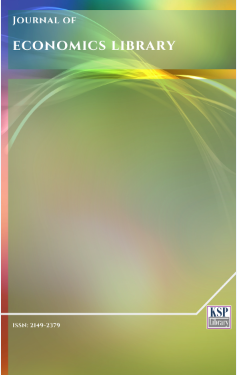Financial Equilibrium in the Presence of Technological Change
Abstract
Abstract. This article explores the issue of observable instability in financial markets interpreted as a long-term process of adaptation to demand for money, which, in turn, is based on the expected depreciation of fixed assets. Exploration is based on verifying empirically the hypothesis that the velocity of money is significantly, negatively correlated with the pace of technological change. The purpose of exploration is to assess the well-founded of policies, which use financial and monetary tools, rather than the straightforwardly fiscal ones, to stimulate technological change. Empirical research suggests that aggregate depreciation of fixed assets is a significant factor inducing slower a circulation of money.
Keywords. Money, Financial markets, Technological change.
JEL. E10, E30.
Keywords
References
Ando, A., & Modigliani, F. (1963). The ‘life-cycle’ hypothesis of saving: Aggregate implications and tests, American Economic Review, 53(1), 55-84.
Braudel, F. (1981). Civilisation and Capitalism 15th – 18th Century, Vol. I, The Limits of the Possible, translation from the French revised by Sian Reynolds, William Collins Sons & Co Ltd London.
Braudel, F. (1983). Civilisation and Capitalism 15th – 18th Century, Vol. II, The Wheels of Commerce, translated from the French by Sian Reynolds, Book Club Associates, London.
Feenstra, R.C., Inklaar, R., & Timmer, M.P. (2015). The next generation of the Penn World Table, American Economic Review, 105(10), 3150-3182. doi. 10.1257/aer.20130954
Kindleberger, C.P., & Aliber R.Z. (1978-2005), Manias, Panics, and Crashes: A History of Financial Crises, 5th Edition, Wiley & Sons.
Meier, P., Vagliasindi, M., & Imran, M. (2015). The Design and Sustainability of Renewable Energy Incentives An Economic Analysis, International Bank for Reconstruction and Development / The World Bank, doi. 10.1596/978-1-4648-0314-7
Minsky, H.P. (1992). The financial instability hypothesis, Jerome Levy Economics Institute of Bard College, Working Paper, No.74. [Retrieved from].
Modigliani, F., & Brumberg, R. (1954). Utility analysis and the consumption function: An interpretation of cross-section data. in The Collected Papers of Franco Modigliani, (pp.3-46), Massachusetts Institute of Technology.
Pinto I.d. (1771). Traite de la Circulation et du Credit, Amsterdam, chez Marc Michel Rey.
Riqueti, V., Mirabeau, M.d. (1760). Theorie de l'impot, Source gallica.bnf.fr / Bibliothèque nationale de France
Samuelson, P.A. (1958). An exact consumption-loan model of interest with or without the social contrivance of money, The Journal of Political Economy, 66(6), 467-482. doi. 10.1086/258100
World Development Report, (2016). Digital Dividends, 2016, International Bank for Reconstruction and Development, The World Bank, doi. 10.1596/978-1-4648-0671-1
DOI: http://dx.doi.org/10.1453/jel.v4i2.1294
Refbacks
- There are currently no refbacks.
.......................................................................................................................................................................................................................................................................................................................................
Journal of Economics Library - J. Econ. Lib. - JEL - www.kspjournals.org
ISSN: 2149-2379
Editor: [email protected] Secretarial: [email protected] Istanbul - Turkey.
Copyright © KSP Library

